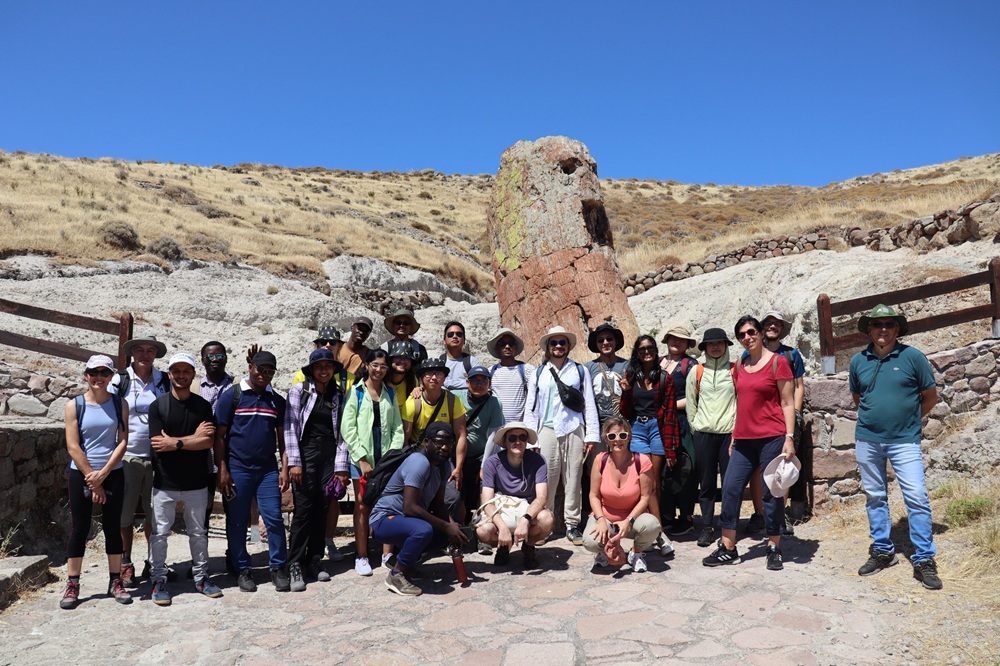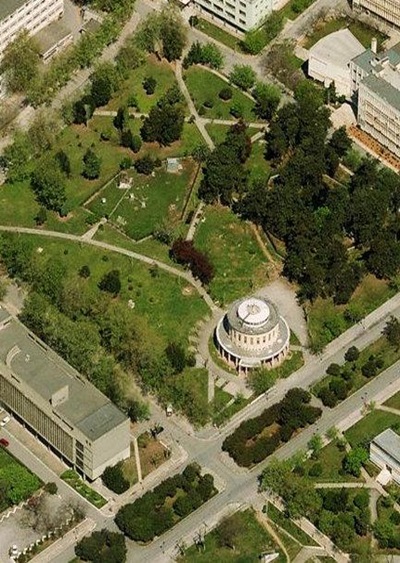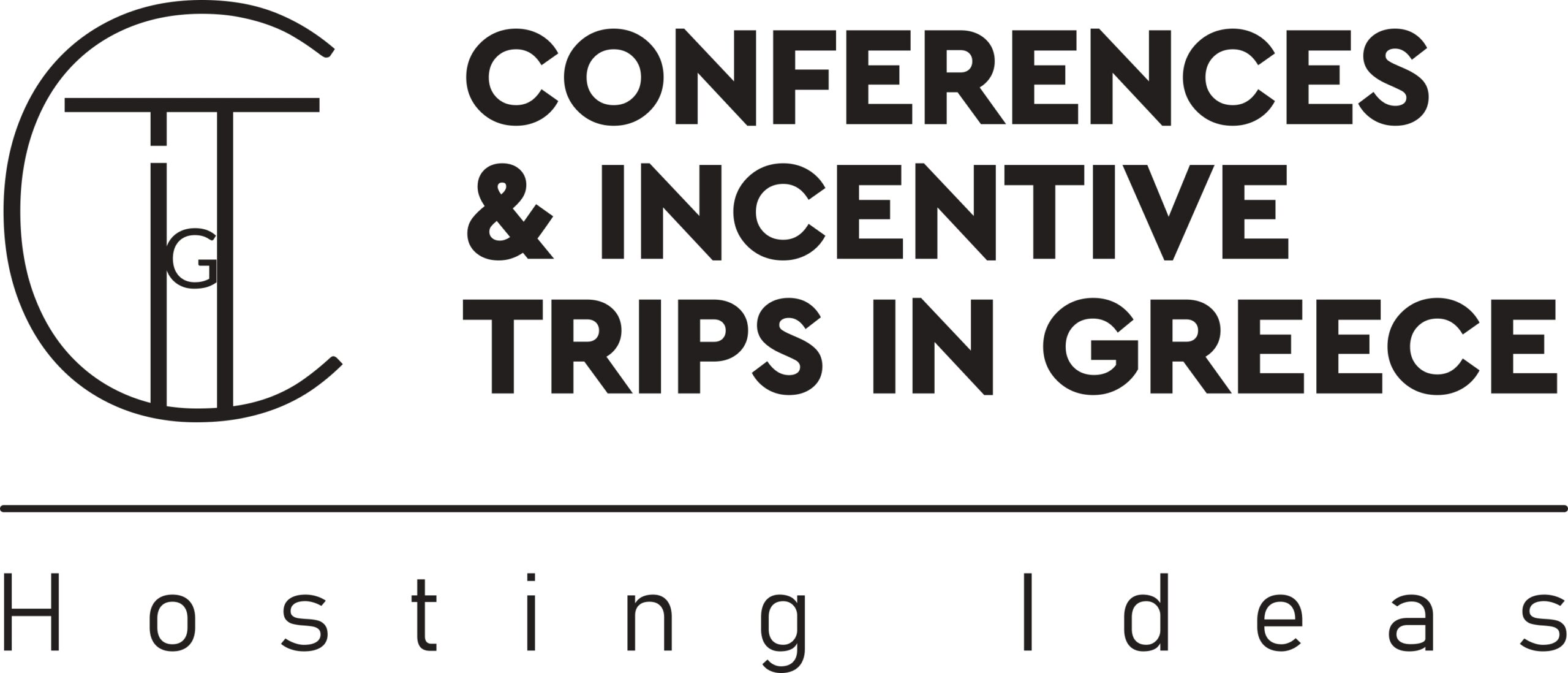
Hara Drinia is a regular professor of Palaeoecology – Sedimentology at the Department of Geology and Geoenvironment of the National and Kapodistrian University of Athens. She teaches a wide range of undergraduate and postgraduate courses, including: Sedimentology, Palaeoecology, Stratigraphy, Marine Ecosystems, Environmental Education, Geoscience Teaching. In addition, he has published a large number of scientific papers in the field of paleontology and stratigraphy, has served as a key member of several research projects and is an active member of eight geoscience committees.
Days of Art in Greece interviewed the current director of the MSc in Earth Sciences and the Environment at the NKUA. Hara Drinia spoke in an enlightening way about her PhD thesis, defined the scope of Palaeology research and reflected on the research possibilities opened up by Artificial Intelligence. Finally, she did not fail to mention how art is able to make sense of science, making it even more attractive to younger students. In her own words, “Art and science are two fields that complement each other and offer unique possibilities in the educational process. The use of artistic tools in teaching allows for a more experiential approach to knowledge, making the understanding of scientific concepts more direct and engaging for students.”
Could you briefly describe the subject of your PhD thesis?
My PhD thesis focuses on sedimentology and specifically on the stratigraphy and paleoecology of sedimentary deposits. The research was carried out in the Apostoloi Basin, in the prefecture of Rethymnon, Crete, where I analysed the composition, structure and evolution of sedimentary sequences. My aim was to understand the geological processes and the paleoenvironmental conditions that prevailed during the deposition of the sediments. My study contributes to a better understanding of the geological history of the area and the processes that shaped the sedimentary environment.
What is the subject matter that Paleontology treats? We would like you to familiarize us with the concepts ,ecostratigraphy, pleistocene, paleovalleys, early and late Miocene paleogeography etc. These are concepts that sound fascinating and that have occupied your research work in many parts of Greece. How revealing have they been about the age of the earth and the response of the subsurface environment to the present microclimate of the country, as well as to the earth’s sphere as a whole?
Paleontology is the branch of geology that studies the fossils and organic evidence of the past, allowing us to reconstruct the history of life on Earth and understand the environmental and climatic changes that have occurred over time. Through paleontological research, we can examine how ecosystems have responded to geological and climatic changes, which is directly applicable to understanding today’s climate crisis.
Ecostratigraphy is an approach that combines stratigraphic and palaeoecological data to highlight the relationship between sedimentary strata and old ecosystems. The Pleistocene, also known as the ‘Ice Age’, is a period of intense climatic variation, during which many of Greece’s present-day geomorphs were formed. Palaeocenozoic valleys are fossilized rivers or valleys that formed in earlier geological periods and give us evidence of how the topography of an area changed over time.
The palaeogeography of the early and late Miocene reveals the evolution of marine and terrestrial environments, as many of the modern geographical structures were formed during this period. My research in various regions of Greece, such as the Apostoloi Basin in Crete, has helped to reveal important geological processes that shaped the subsurface environment and influenced the present microclimate of our country.
Palaeogeological studies help us to understand not only the age of the Earth but also the dynamic changes that have occurred in the past, providing valuable information on how the subsurface environment influences modern climate, both locally and globally.
How do external changes in climate change affect the Earth’s stratigraphy? Given the interaction between surface and subsurface processes, to what extent has mining and hydrocarbon extraction affected the atmospheric environment and the quality of life of living organisms?
Climate change affects the Earth’s stratigraphy mainly through sediment deposition, erosion and changes in groundwater. External changes, such as warming, extreme rainfall or prolonged droughts, accelerate geological processes, affecting the structure and composition of surface and subsurface formations.
Mining of minerals and hydrocarbons is an additional disturbing factor. The drainage of groundwater, the destabilisation of geological strata and the absorption of pollutants from the air and soils deteriorate the overall balance of the ecosystem. At the same time, the burning of hydrocarbons contributes significantly to the concentration of greenhouse gases, accelerating climate change.
Therefore, anthropogenic interference in the underground creates a vicious cycle of environmental impacts, where the very changes caused by mining amplify the effects of climate change, affecting both the atmospheric environment and the quality of life of living organisms.
You refer in your publications to living organisms on the islands of the country and their microclimate that created new populations of mostly extinct wild animals. Would you like to tell us a little about this scientific field of yours?
My research within the INSOLARIO project focuses on the study of the biodiversity and paleoecology of the Greek islands, examining how microclimate and geomorphological changes contributed to the formation of distinct ecosystems in the past.
INSOLARIO was a research activity within the framework of the THALES project, which aimed to strengthen scientific research in Greek universities. The THALES project was funded by the Operational Project “Education and Lifelong Learning” and co-funded by the European Union and the Greek State.
INSOLARIO focused on the study of the paleoecology and paleogeography of the Greek islands, examining how environmental and climatic changes affected biodiversity and the formation of island ecosystems. Through interdisciplinary approaches including geology, paleontology, ecostratigraphy and geomorphology, INSOLARIO contributed to the understanding of the evolution of island environments and their interaction with climate variability.
Its results are particularly important as they shed light on past changes that have affected life on islands and provide useful data for the protection of today’s island biodiversity, especially in the face of modern climate challenges.
Through the study of sedimentological and palaeontological data, we analyse how the isolation of the islands and sea level fluctuations led to the development of unique wildlife populations, many of which are now extinct. These data provide valuable insights into the paleogeography of the Aegean and the evolutionary processes that shaped today’s biodiversity.
The study of these past changes is crucial, as it helps us to understand the long-term impacts of environmental changes on island life and to propose strategies for the conservation of modern island biodiversity, especially in the light of today’s climate challenges.
You published a study on Grey literature at the Greek university. Would you like to report your conclusions ?
Indeed, my collaboration with Mr. Alexandros- Aristotelis Koupatsiaris has yielded significant results, as shown by our publication in the MDPI journal Geosciences. The paper, entitled “Exploring Greek UNESCO Global Geoparks: A Systematic Review of Grey Literature on Greek Universities and Future Research Avenues for Sustainable Development“, examines the grey literature of Greek universities on Greek UNESCO Global Geoparks from 2000 to 2022. Through a systematic review, 28 studies that met the predefined criteria were analysed, revealing a growing interest in Geoparks, especially in the fields of geotourism, geology, management and education. Our study suggests future research directions focusing on promoting the socio-economic and cultural aspects of Geoparks, collaborative management, addressing climate change and enhancing geo-environmental education, contributing to the UN Sustainable Development Goals.
Our study highlighted the growing role of grey literature in the Greek university, especially with regard to the Greek UNESCO World Geoparks. By analysing material from 2000 to 2022, we found that although traditional scientific publications dominate, grey literature – which includes theses and PhD dissertations, project reports, conference proceedings and technical reports – provides essential information on issues of geoconservation, geotourism and geoenvironmental education.
An important finding of the study was that the grey literature is not sufficiently accessible or systematized, making it difficult to use in research and policy making. Although it has contributed to the understanding and promotion of Geoparks, the lack of organized archives and the absence of open access limit the dissemination and utilization of this data.
The study concluded that there is a need for the creation of a national grey literature repository that will allow easier management and use of the material by researchers, managers and policy makers. In addition, the importance of strengthening interdisciplinary and interdepartmental cooperation was stressed in order to integrate grey literature into future studies and strategies for sustainable development of Geoparks and environmental education.
You have been working on urban geology and you have prepared a study on the geological heritage of the centre of Athens.Would you like to tell us a little bit about it?
The paper “The Geosites of the Sacred Rock of Acropolis (UNESCO World Heritage, Athens, Greece): Cultural and Geological Heritage Integrated” (Drinia, Tripolitsiotou, Cheila, Zafeiropoulos) examines the interaction of geology and cultural heritage at the Sacred Rock of the Acropolis of Athens, a UNESCO World Heritage site.
The main objective of the study is to highlight the geological significance of the Acropolis and to integrate its geological characteristics with its cultural value. The research focuses on:
- The geological composition and the formation of the Sacred Rock, highlighting the lithology and the tectonic processes that shaped the relief of the area.
- The influence of geology on the monuments of the Acropolis, examining how natural factors influenced the construction and preservation of ancient buildings.
- The highlighting of the Acropolis geosites as part of the cultural heritage, promoting geoconservation and the connection between the geological and cultural value of the area.
The following emerged from our research:
- It is confirmed that the Sacred Rock of the Acropolis consists mainly of Upper Cretaceous limestones, which have influenced the morphology of the area and the strength of the monuments.
- The natural durability of limestone allowed the construction of the important classical monuments, while the tectonic structures (faults and discontinuities) influenced the stability of the structures.
- Geological processes and erosion have affected the preservation of archaeological findings, highlighting the need to protect the natural background of the monuments.
- The paper proposes the preservation and promotion of the Acropolis’ geosites, integrating them into geotourism and environmental education programmes, in order to enhance the understanding of the relationship between geology and culture.
The study underlines that the Acropolis is not only a cultural heritage monument, but also an important geotope of particular scientific interest. The geological and cultural value of the site are inextricably linked, which reinforces the need for an integrated conservation strategy that takes into account both its cultural and geological heritage.
In your educational work, you use the tools of art to offer your students a more experiential learning experience. Elements from your scientific field can be found in works such as those by Jules Verne, Harry Potter and Frank Herbert (*Dune*). Would you like to talk about the relationship between art and science? How necessary is the integration of art into the modern educational process? Do you think that peripatetic teaching can maintain its relevance in an age of over-information and rapid accumulation of knowledge?
Art and science are two fields that complement each other and offer unique possibilities in the educational process. The use of artistic tools in teaching allows for a more experiential approach to knowledge, making the understanding of scientific concepts more direct and engaging for students.
Works such as those by Jules Verne, Harry Potter or Frank Herbert (Dune) use scientific principles and geological evidence, demonstrating how science can inspire literature and vice versa. This connection helps to foster creative thinking and science fiction, which are essential elements for knowledge and innovation.
Peripatetic teaching, a method dating back to Aristotle, retains its relevance even today, especially in an educational context where information is readily available but critical processing requires guidance. Experiential learning through exploration, observation and the linking of the theoretical with the practical is essential for knowledge to acquire depth and substance. In an age of rapid developments and hyper-information, the integration of art and experiential learning into teaching can provide a more meaningful educational experience.
The impressive accumulation of knowledge is certainly the result of the development of information technology and artificial intelligence.How much will AI and life sciences collaboration help your scientific field of research? What is that intractable problem that could help and where we expect revelations in the coming years?
Artificial intelligence (AI) and collaboration with the life sciences have the potential to bring revolutionary changes to the field of geosciences, particularly in stratigraphy, palaeogeography and earth observation. Big data analysis, simulation of complex geological processes and improved understanding of paleoclimatic changes can be greatly enhanced by the use of AI.
One of the most intractable problems in the field concerns the accurate reconstruction of paleoenvironments and climate changes in great temporal and spatial detail. AI can contribute to the analysis of huge geological and biological datasets, detecting patterns and interactions that have been difficult to discern until now.
We expect that in the coming years, advances in machine learning and neural networks will allow us to create more accurate models of geological and climate evolution, which will help both in understanding the past and predicting the future. Interdisciplinary collaboration with the life sciences, especially in the study of micro-organisms and fossils as environmental records, can reveal valuable insights into the interactions between biosphere and geosphere, with direct applications in climate change management and earth observation.
If you want to tell us, what were the influences that made you personally decide to get involved in this scientific field? What is the book ,artwork ,or film that propelled you to this choice?
My decision to pursue geoscience came from a combination of personal experiences, academic stimuli and an enduring curiosity about the geological history of the Earth. From an early age, I was fascinated by the idea that rocks and fossils hold millions of years of history, capturing the changes of the planet through time.
Books like *Journey to the Centre of the Earth* by Jules Verne made me imagine the underground world full of geological wonders, and later, scientific works on paleogeography and geoconservation helped me understand the importance of research in this field.
In the field of art, works of landscape painting that depict geomorphs with detail and precision, such as those of the Romantic painters, inspired me to see the natural landscape not only as a field of research but also as an element of cultural heritage that links the past with the present.
Geoscience, after all, is a field that combines many different approaches – from pure research to its connection with education, conservation and understanding of man’s relationship with his geological background. This multidimensional nature was the final impetus for my choice to devote myself to it.







Leave A Comment